Daniel Lefcourt
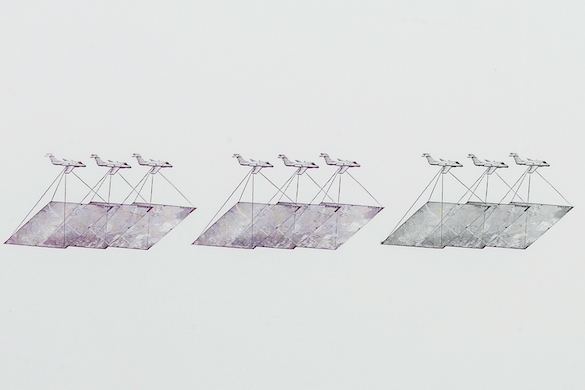
If its attempts to transcend its own condition as colour spread on a plane occupy a large part in its history, painting is nevertheless still a physical area from which to address the surrounding world. While the majority of Westerners henceforth spend most of their time with their eyes glued to a luminous rectangle —hi there, who you are reading this text humbly printed on paper—, painting, in the words of Daniel Lefcourt, allows slow-looking, and have the ability to speak of perception, of touch. It would be, more than ever, topical.
It is not, however, a matter of contrasting the static quietness of the otherworldly with the still largely undetermined way in which new tools and media are informing our way of looking at things, but, quite to the contrary, of letting there be a link between the terms of this apparent incompatibility in a dialectic favourable to political reflection. Yes, political.
To this end, the New Yorker’s painting involves state-of-the-art techniques as far as the production of precision images is concerned and, by denying them in one and the same motion, gives rise to images whose defects and imprecisions form their content. And the space it opens up is not a reassuring space.
In a short text you wrote to introduce your show at Blum & Poe gallery1 earlier this year, you relate an anecdote about your first visit to the TOR network and your discovery of video stills that you describe as “what filmmaker Harun Farocki has called Operative Images – images that exist merely to gather data” and of a document “on the history of photogrammetry – a technique in which photographs are used to measure scale and distance”. Is that where your interest in remote sensing techniques (measuring techniques such as laser scanning or aerial photography that are ways of gathering dimensional data of an object without physically interacting with it) stem from?
In some sense, yes – but this narrative (like the artworks themselves) is actually a composite. It is an amalgam of multiple experiences over many years. Anyone who visits WikiLeaks and watches drone footage of American atrocities, or discovers strange files on the darknet, might have a similar story to tell.
Aerial perspective has been a recurring theme in my work since I studied experimental film and painting as an undergraduate. The first artwork I exhibited publicly in 1998 was a video2 recorded from above, mimicking the perspective of street surveillance technology.
I returned to aerial perspective and the technique of photogrammetry a few years later for a series of large scale digital composites, such as Optimism is a Force Multiplier – the title is a quote from the former U.S. Secretary of State Colin Powell.
My interest has been renewed lately as I have begun to understand the deep historical connection between military reconnaissance techniques and the development of 3D scanning, printing, and manufacturing. I’ve been learning about figures such as Col. Aimé Laussedat the military cartographer who invented early techniques for what is now called remote sensing – measuring space and distance without direct contact. Some believe he commissioned Nadar’s famous first photos from a balloon in order to create a map of Paris. Contemporary 3D laser scanning, used for everything from Google Maps, to factory automation, and even surgery on our bodies, is a direct outgrowth of Laussedat’s military research in the 1850’s.
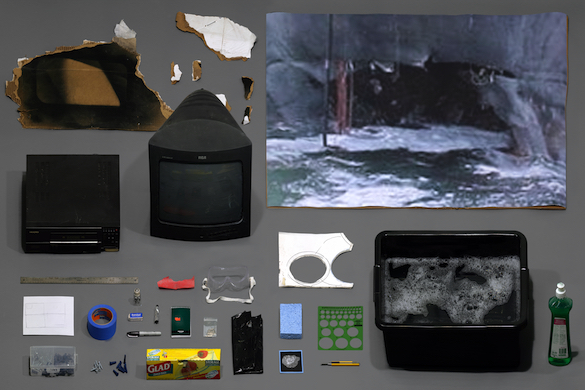
Daniel Lefcourt, Optimism is a Force Multiplier, 2005. Courtesy Daniel Lefcourt ; Campoli Presti, London / Paris.
This leads us then to your latest bodies of work, Debris Field (2011), Cast (2013-2015) and Anti-Scan (2015), that one could describe as paintings but which, at least in the process of their making, pertain as much to temporary installation with found material, digital photography, 3D modeling and sculpture as to painting. How did you come to set up such a multi layered and multi media process to produce paintings on canvases?
The development of this process came out of a desire to create an artwork that is at once alive and dead. Obviously, I am using an older set of terms here, but I believe they may be relevant again at this moment, so let me elaborate. The language around early performance, happenings, conceptual art, and Fluxus, often invoked the desire to create a living artwork – not dead in the museum, like so many dried up, commodified, paintings. Once painting was supposedly ‘overcome’, the types of actions and materials available to the artist must have seemed limitless. But of course the problem of documentation became immediately apparent as a material constraint – and, as we know now, photographic documentation is the coffin in which so much art from this era now rests.
The broader dematerialization of the art object failed to overcome the problems of dead painting as Lucy Lippard and others had so optimistically imagined. The relation of performance art to the spectacularized condition of art today only confirms this. A similar fantasy – of overcoming the constraints of the museum, of material limitations, and the model of painting as commodity form – occurred again in the late 90’s and 2000’s in relation to the potential of the Internet (think of Seth Price’s Dispersion). Today, with so-called Post-Internet Art, the fantasy of ‘the digital’ as an infinitely mutable and boundless arena – tied to hybrid identities and genders – is evident in the symptomatic use (or abuse) of 3D imaging and fabrication.
What I have been trying to do these past few years is create a set of processes that allow me to put some of these terms into dialectical play, and hopefully develop a more nuanced understanding of the real material constraints of ‘the digital’.
With the Anti-Scan works, I begin by creating an aleatory surface using paint, pigments, and substrates such as wood, and canvas. While the paint and materials are still wet, and sometimes moving, I quickly scan them using specialized photogrammetry software to create a 3D model. Interestingly, the wet paint cannot be properly scanned because of the reflections and movement. So the actual material generates a kind of digital hallucination.
From there, I output the model back into material form. This is done by CNC milling a large foam mold of the model, pouring paint into the mold, and then finally, peeling the dried sculptural paint-skin and sticking it onto canvas. In a sense, the digital hallucination is cryogenically stored as painting.
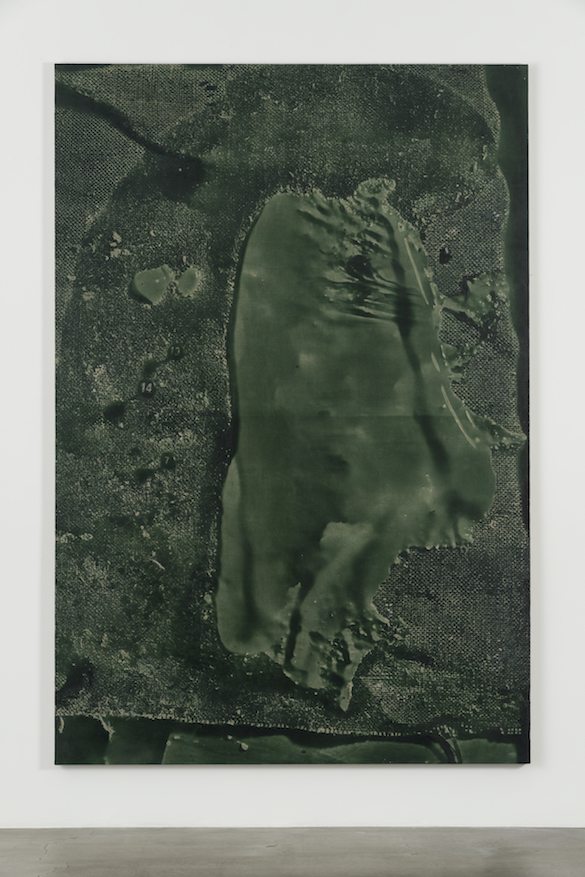
Daniel Lefcourt, Cast (Remote Sensing), 2015 . Pigment PBK31 et uréthane sur toile. Courtesy Daniel Lefcourt ; Campoli Presti, London / Paris.
Could you be interested in showing the original pictures?
The question of ‘the original’ is important to me – I studied with Allan McCollum and he has had a major influence on my thinking here. As with Allan’s work, there is no original image for me to show. The ‘original’ studio activity is ephemeral. The ‘original’ photographs are ‘operative images’, and are only used to provide spatial data for the software. The ‘original’ 3D model is filled with errors and glitches. More importantly, the 3D model has no intrinsic ‘original’ form that is legible to humans – it is simply a table of numbers designating millions of xyz coordinates. Even the paintings are not so much ‘originals’ as ‘original iterations’. Each cast of the mold is one potential form in which the spatial data can be stored and displayed.
But is it important that the viewers question themselves about the process?
It’s definitely impossible for the viewer to reconstruct how the work was made. So it is not a purely positivist ‘process art’ in that sense. Instead I hope to create a tension between the pronounced facture evident in the work’s layered surface, and the sense that what we are looking at is remote, and possibly a phantasm. That all said, I would argue this is still a materialist approach to painting.
I went to see the Omer Fast show at the Jeu de Paume (in Paris) this afternoon. I had never seen his work. The videos there play with a very similar tension. One even begins to suspect that this fictional film might also be non-fiction. The narratives in the films just keep slipping – any kind of conclusion is continually postponed.
Is this what happens when you look at your paintings?
Perhaps the common interest that I recognized is that the artwork is designed to create a doubt in the viewer – a doubt around the verifiability of vision itself. But this doubt is what makes us look closer and hopefully to self-reflect.
In a way, I do not feel the paintings are mine. The paintings are mysterious to me because there’s so much chance involved: the 3D models are generated using chance… There is a blindness and an absence at the core of the project.
You produce more paintings than you show, and destroy many of them, what makes you decide they are ‘successful’?
When they display multiple layers of space, when the surfaces reveal a complex strata, when they have a luminous quality…
So it’s about pure questions of painting, typically Renaissance pictorial conventions: perspective, space, light, surface…
(Laughs) In a way the answer is “Yes”, I am interested in aspects of painting that are not typically associated with critical, ambitious art, such as light, space, and surface – but I am not so much interested in Renaissance conventions, as I am the conventions of scientific and military imaging. I am interested in the pictorial conventions found in fields such as cartography, archeology, and forensics. I use the same techniques as scientists from these fields, so my criteria for what is a successful painting is based on how well the specific characteristics of these techniques are conveyed. For instance it is important that the ‘strata’ of paint are visible. It is important that the painting emphasizes both map-like and model-like characteristics. It is also important that the work is not ‘composed’, but instead is compositionally generated by the process of digital input and output.
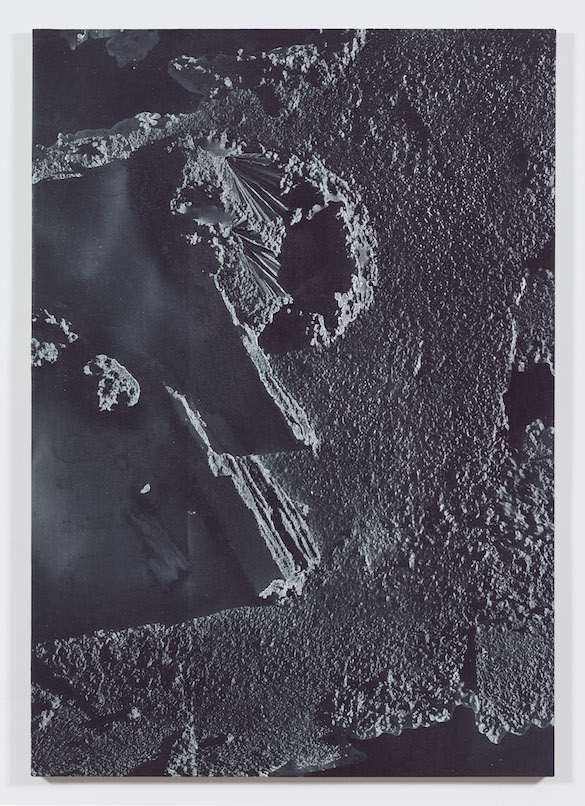
Daniel Lefcourt, Anti-Scan, 2015.
Pigment et uréthane sur toile, 203,2 x 142,2 cm. Courtesy Daniel Lefcourt ; Campoli Presti, London / Paris.
These paintings are monochromes in fact. Because the color only happens in the making, you don’t dilute it.
I brush a single color into the mold. It’s interesting to think of it as a monochrome – I had not thought of it in that way. The pigments I use, be it the Perylene green or the violet pigment, appear black when they’re at their maximum density but they also can be very bright and saturated in the thinner areas. This helps create a tension between the surface and the pictorial space of the image.
In the end, you create an image that couldn’t exist through a human eye.
Even though photography based and using techniques operated by architects, archeologists, forensics practitioners, cartographers or the military, these paintings depict images that don’t exist, that don’t fit in the definition we still have of an image.
That’s right. I am using the same techniques as used in fields which are primarily concerned with accurate measurement, but I am trying to explore the processes in ways that, say, an archeologist or cartographer would never do. I intentionally misuse the technology by attempting to capture something that is beyond the limits of what is technologically possible. The result is a representation of exactly that which cannot be recorded. So there is an absence at the core of the project.
I named my last Paris show at the gallery Campoli Presti ‘Tête’ after the Jean Fautrier series of paintings Tête d’otage (1945). Here also, there is an absence at the core of his paintings because Fautrier never saw his subjects directly. What is particularly interesting to me about Fautrier is that this absence manifests itself in an obsession with surface. I saw these paintings when I first came to Paris, they were displayed at the Musée d’Art Moderne. I was seventeen and I hated them. I thought they were awful and, in a way, I still do, but today I see a connection between them and my recent work. Both are about the unique type of trauma of being a bystander, or of what we could call a ‘remote witness’.
Together with these recent sets of paintings (Cast and Anti-Scan), you showed in Paris and London3 a series of imprints of laser engraved stamps which draw your work back into the realm of figuration in a more obvious way.
I started the project about eight months ago when I learned how to use a laser etching device to make rubber stamps. The drawings are created by individually stamping each image, one at a time. They developed out of a web-based project commissioned by Dia Foundation4. The motifs in these drawings, as well as with the Dia project, all refer to different historical moments of image making, reproduction, and storage. Particularly, most of the images are concerned with measurement and scale. It’s a tautological project in some sense.
For example, there is an image of a ruler I purchased from a forensic supply company – it is a ruler designed to be photographed at a crime scene; then there is the only image we had of Pluto – until this past summer; then a diagram illustrating early aerial photogrammetric technique using overlapping images shot from an airplane. The images continually shift, pointing towards different scales and historical times.
The color of the drawings mimics an aspect of newspaper print production, but it also varies, creating a metered tempo to the work. The composition of each drawing is left-justified, as if we are to ‘read’ each image in relation to the other images. But I think the composition also brings to mind early HTML web layout, comic books, musical scores, and film storyboards. So, the process has allowed me to explore sequence, narrative, and rhythm. It’s a kind of play using the idea of interface and reading.
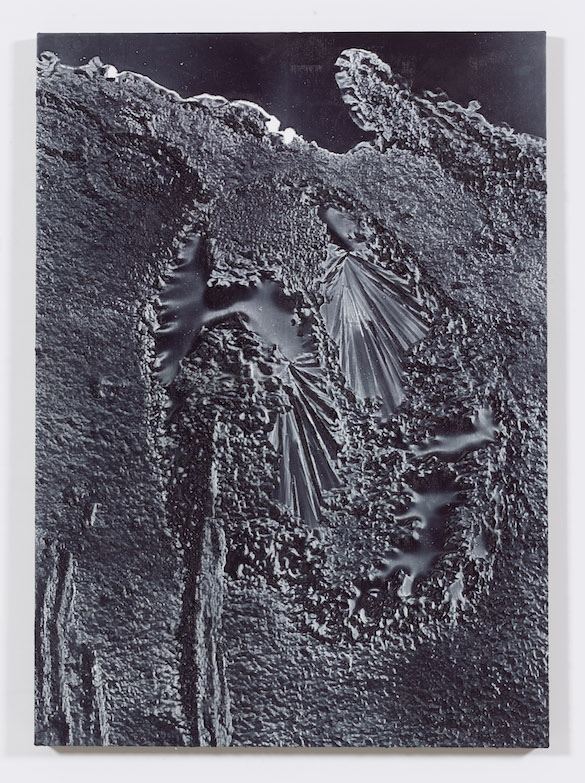
Daniel Lefcourt, Anti-Scan (for Colonel Aimé Laussedat), 2015. Pigment et uréthane
sur toile, 142.2 × 101.6 cm. Courtesy Daniel Lefcourt ; Campoli Presti, London / Paris.
So, according to you, painting is still, and maybe more than ever, a field from where to address political issues?
At this point, we have to acknowledge that there is no form of art making that is inherently more critical or politically engaged than any other. For instance, it is a mistake to assume that collaborative work, or post-studio practices, are somehow inherently more critically engaged than painting. Hito Steyerl has spoken about how the space of the gallery is a battlefield and I believe that is true – it is as much a battlefield as the so-called real world. Considering the radical new ways our visual perception is being reconfigured by technology, I don’t think other art forms have the ability that painting does to engage our changing perception of surface, space, and light.
All the discussion about ‘the digital’ in contemporary art has been about digital exchange. But I am interested in digital production… and how digital production constructs perception. I think we need to revisit the topic of production, to talk about the actual labor (including automated labor) involved in making objects and images – I believe we lack a vocabulary for discussing how images and objects are made today. Because of this, we also lack a robust vocabulary for talking about the politics of perception. Painting remains a potent space where we can talk about this. Or, I should say, by engaging Painting we can engage in – and take sides in – the politics of perception.
1 http://www.blumandpoe.com/exhibitions/daniel-lefcourt#press1. From March 7 to April 18 2015, Blum & Poe, Los Angeles.
2 https://www.youtube.com/watch?v=t0FGIezV3kw
3 “Anti-Scans”, from October 14 to November 15 2015, Campoli Presti London and “Tête”, from October 22 to November 21 2015, Campoli Presti Paris.
4 http://www.diaart.net/lefcourt
- From the issue: 76
- Share: ,
- By the same author: Paolo Cirio, Sylvain Darrifourcq, Computer Grrrls, Franz Wanner, Jonas Lund,
Related articles
Céline Poulin
by Clémence Agnez
Calla Henkel & Max Pitegoff
by Ingrid Luquet-Gad
Dena Yago
by Ingrid Luquet-Gad